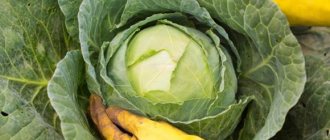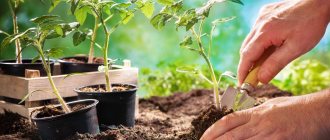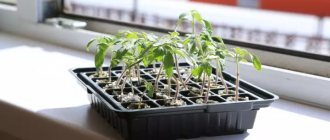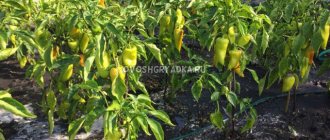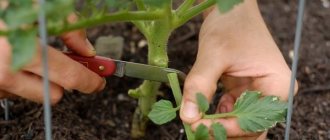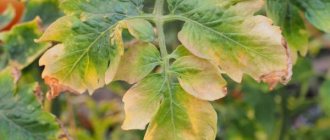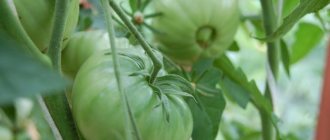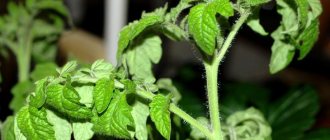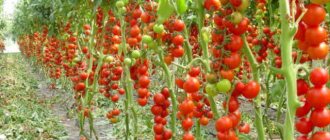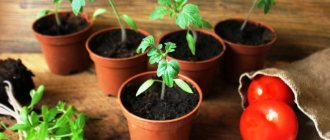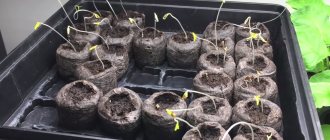When to start and whether to pick off the bottom leaves of tomatoes
To begin with, it must be said that there is no clear opinion as to whether it is necessary to pick off the lower leaves of tomatoes.
Some gardeners insist on mandatory pinching of tomatoes, since this procedure increases productivity; others recommend being very careful when removing leaves from tomato plants.
After all, there are often cases when, after cutting off the lower deciduous part of the bush, the plant stops growing and developing.
So, the main reasons why it is recommended to trim the leaves of tomatoes include:
- improved air circulation;
- preventing moisture from stagnating;
- improvement of photosynthesis;
- reducing the risk of infection with various fungal and infectious diseases;
- increasing productivity indicators.
Which leaves should be removed?
When deciding whether to pick off the lower leaves of tomatoes, you must first figure out which leaves need to be removed and which can be left. Carefully inspect each tomato bush and remove all dried leaves.
There is no need to wait until they begin to fall off on their own. If the sheet plate dries out, it means that it will no longer bring any benefit.
At the same time, we draw your attention to the fact that you should remove not only the lower dry leaves, but also those located in the central or upper part of the bush. Be sure to trim off any yellowing foliage. Yellow or spotted leaves are considered an ideal environment for the development of various diseases characteristic of tomatoes.
Yellow or spotted leaves are considered an ideal environment for the development of various diseases characteristic of tomatoes.
Be sure to trim off any yellowing foliage. Yellow or spotted leaves are considered an ideal environment for the development of various diseases characteristic of tomatoes.
How to perform this procedure, you ask? Thinning a tomato bush is carried out similarly to the procedure for thinning a bush. However, you only need to trim those leaves that are on the north side.
Thus, you improve air circulation and prevent the possibility of infection with various fungal or viral infections.
Terms and rules of the procedure
Don't know when to pick off the bottom leaves of tomatoes? It would seem that what could be easier than going around the area of the garden where tomatoes grow, inspecting the plants and removing all yellow, dry and damaged leaf blades.
However, an incorrect or untimely procedure can lead not only to low yields, but also to the death of tomatoes.
For this reason, we recommend that you first familiarize yourself with the terms and rules for removing leaves on tomatoes.
How can you tell if the seedlings have already taken root? If new shoots and sprouts begin to appear on the bushes, you can begin to inspect your garden property.
You need to start with those vegetable crops that look bad or have obvious signs of some disease. First, remove the lower leaves and only then proceed to thinning the bushes.
Now you know when and how to properly pick off the lower leaves of tomatoes. Your future harvest may depend on the correctness and consistency of pinching, so do everything thoughtfully and without unnecessary haste. After all, in the impulse of “I would like to do everything quickly and correctly,” you can tear off a necessary and viable leaf.
Gardener tips
If you are still in doubt and can’t decide whether you need to pick off the lower leaves of tomatoes, we bring to your attention some tips from experienced gardeners:
“I have been growing tomatoes for more than one year. At first, after listening to a lot of advice from friends, I decided to plant and tie up tomatoes. To my great chagrin, the harvest was very meager. I decided to look into the reasons and find out why the tomatoes didn’t produce any fruit.
After reading a lot of different literature and watching dozens of videos, I found out that not all varieties should be plucked. Thus, determinate or low-growing varieties, the height of which barely reaches 1 m, do not need to be plucked, but to improve the yield of indeterminate or tall crops, pinching and tying are recommended. (Olga, Orenburg)"
“Tomatoes are our entire family’s favorite vegetable crop. For this reason, I had to thoroughly study how to plant and grow tomatoes, when to pick off the lower leaves and how to do it correctly. However, not everything is as simple as it might seem initially. It turns out that it is necessary to take into account the characteristics of the weather and climate region.
If you plan to grow tomatoes for more than one year, then keep yourself a diary where you can note everything about planting, care features and yield of each planted tomato variety. (Ekaterina, Arkhangelsk region).”
What is the benefit of removing tomato leaves?
According to the biological characteristics of nightshade plants, which include tomatoes, the average leaf life is 3-3.5 months. That is, after serving their allotted time, they begin to dry out.
Naturally, the first to die off are those that appeared first - in the lower part of the bush. Leaves that have begun to turn yellow are already a burden for the plant and must be removed.
The second reason for the need for this procedure is that a large vegetative mass takes energy away from the bush for its maintenance, to the detriment of fruiting. The bush is fattening, the fruits on it are small and tasteless, but the leaves are huge and bright.
The third reason why it is recommended to tear off the lower leaves is that almost all of them are in contact with the ground, and excess moisture can cause fungal spores to enter the plant.
Additionally, during rain and watering, if the beds are not mulched, drops of water are repelled from the soil and settle in the lower part of the leaf blades that are in contact with the soil, infecting them with pathogenic microflora.
When the lower part of the stem is exposed, this danger is reduced tenfold. All lower leaves located below the first cluster with ovaries can be safely removed.
The advantages of manipulation include the fact that if you trim the leaves of tomatoes, the loss of moisture from the plant itself will be reduced due to reduced evaporation, and this is very important in places where there is a problem with watering.
In addition, the presence of large leaves covers the soil, does not allow air masses to circulate freely between the bushes, and moisture does not evaporate from the soil surface.
This leads to increased development of molds and the risk of various fungal diseases, in particular late blight, is maximum. This operation is especially relevant in a greenhouse, where ventilation is complicated due to the lack of wind.
At the same time as the lower leaves, fattening shoots growing in the lower part of the bush should be removed, as well as all yellowing and drying leaves throughout the bush (it no longer needs them).
Also useless will be shoots growing above the brush with ovaries, leaves on the northern or shaded side of the bush, covering the ripening brushes (but if there is a risk of sunburn, it is better to leave them). If you follow the rules for tearing off leaves, the risk of infection will be minimal, and tomato bushes will delight you with an excellent healthy harvest.
Arguments of opponents of removing leaves on tomatoes
There are not many of them, only two.
- The first is that nature has determined how the bush will develop, when, in what order and how the leaves die. You cannot interfere in this process.
- The second argument is that after the leaves are torn off, the bushes begin to hurt, since pathogens enter the tissues through open wounds.
The counterarguments are as follows. Are you ridding a grape bush of extra shoots and old leaves? This helps to increase the yield and protects the bush from diseases. Without such operations, the grapes return to a wild state, unless they die from oidium and mildew.
The tomato bush is similar - if you don’t help it, it will become overgrown with wild shoots, quickly get sick and “burn”, and there will be a minimum of fruit or even the entire crop will die. And if we follow this logic, we must abandon stepsoning and the formation of indeterminate varieties. And what?
According to the second, if you pick off the leaves of tomatoes correctly, as shown in the video, then the wounds heal very quickly and no infection occurs. The thinning technology is described below.
Removing stepchildren
This shoot is superfluous, there will be no fruit on it, but nutrition will be consumed for its growth.
If you look closely at the seedlings, you will notice that only one shoot is growing. In this condition, we plant it in open ground. At a certain stage (it all depends on the variety), new, young shoots begin to form in the internodes - these are stepsons .
The varieties of the last century were not so large and productive and did not require pinching. Modern varieties, high-yielding and large-fruited, are not able to bear and feed everything that the breeders put into it . Therefore, to get a good harvest, the bush needs to be normalized. Removing stepchildren is a normalization of the harvest.
Advantages
Removing excess shoots increases and speeds up fruiting.
- We speed up fruiting . The greenhouse is designed to get a very early harvest. If the plant spends time growing shoots rather than setting fruit, then we will not get an early harvest;
- Increasing the size of the tomato . The plant cannot grow a lot of huge fruits (either a lot of small ones, or a few, but large ones);
- We do not allow tomato plantings to turn into a “jungle” . It is the thickets that cause all the troubles. Pests and pathogens need their “home” and find it in thickets of shoots and foliage.
Which varieties should you prune and which should you not?
Not all varieties and hybrids behave the same in culture. Naturally, there is no one law of stepsoning .
It’s not difficult to understand the nuances; you just need to understand why we take stepsons.
Super early variety
Early, low-growing varieties of tomatoes do not require pinching.
If a super-early variety is grown in a greenhouse, in order to obtain very early, expensive products, then determinate (low-growing) varieties are selected. They are not large-fruited and do not produce such a huge harvest as tall ones, but they ripen quickly.
Many vegetable growers leave such varieties without pinching . They grow into bushes and quickly produce crops. Each growing stepson ends with a fruit cluster, therefore, there is no point in cutting them. If the stepsons are removed, the harvest will be very low.
These varieties ripen quickly. Next, the bushes are removed from the greenhouse, leaving room for the re-rotation crop.
The exception is varieties of modern selection that produce fruits of 350–400 g. The bush cannot bear a lot of such fruits, therefore, they need to be rationed by removing the stepsons.
Tall (indeterminate) tomato
On tall varieties, most of the stepsons are removed.
The culture of tall (indeterminate) tomato is completely different. Such varieties are usually very productive , with large and very large fruits. They do not produce “quick” fruit, but their tomatoes are very massive.
Such a tomato cannot be grown without pinching. In this case, the crop is led into one or two shoots, removing absolutely all the shoots.
Semi-determinate varieties and hybrids
There are also semi-determinate varieties and hybrids. Their bush grows to 60–70 cm and is crowned . Such varieties cannot be overgrown.
As a rule, they allow the shoot to grow, set a fruit cluster, grow a couple of leaves above the cluster, and then pinch off the tip of the shoot.
More details about pinching medium-sized varieties are shown in the video:
How and when to remove stepsons?
There is no consensus among vegetable growers on this matter. In the literature you can find recommendations for:
Such a stepchild can already be deleted.
No difference. Agricultural technology involves breaking off the stepson at a distance of 1 cm from the base at the moment when it has reached a size of 2–3 cm . This can be done in a way that is convenient for the vegetable grower, either with a fingernail (the tissues are young, tender and pliable) or with a cutting tool (scissors). Some people believe that if you leave the “stump” larger, then stepsons will not form. In fact, this is not so, there is no connection between the hemp and the next stepson.
It is better to perform the operation early in the morning. During this period, the fullness of tissue juices is the highest and the stepsons are fragile. They are easy to break off.
Stepchildren can be removed in any convenient way.
You cannot grow large stepsons; the larger the stepson, the more nutrients are spent on its reproduction to the detriment of the harvest.
The stepson-forming properties of all varieties are different:
- Some constantly, tirelessly form stepchildren (vegetable growers say “they drive the masses”). Such tomatoes have to be planted several times a season. In this case, stepsons can form in the same place;
- Some varieties form few stepsons and only on the lower part of the bush . They are easier to work with. However, if the top is broken and there are no more stepsons, it will not be possible to renew the bush;
Soil fertility matters
Whatever the stepchild-forming ability of the variety, if the soil is not fertile, then the plant is not able to grow vegetative mass and in this case there are fewer stepchildren.
If the soil is fatty and nutritious (especially high in nitrogen), then the stepchildren grow rapidly. In this case, the plant can grow not marketable fruits, but green mass.
Where to “place” the stepchildren?
Experienced vegetable growers have long put stepchildren to their service. They use them as additional planting material.
For a stepson to become a seedling you need to:
- Grow the lower stepson to 12–15 cm .
Select suitable branches.
We place the jar with stepsons in a shaded place.
After the white roots appear, we plant the seedlings in the garden bed.
Such seedlings lag behind the mother seedlings in fruiting by 12–15 days .
Correct bush formation
Knowing for sure when to trim the leaves of tomatoes, the gardener will be able to form each bush that needs agricultural technology. Today, the procedure is performed depending on whether the tomatoes belong to a particular variety:
- determinant;
- superdeterminant;
- indeterminant.
If the tomatoes chosen for cultivation are tall, the bush is formed into one, two or three main stems, choosing the best stepsons extending from the upper raceme. The remaining shoots are removed without waiting for the sprout to grow more than 5 cm.
Do not use pruning shears or a knife. Form a bush using your fingers. They clamp the shoot and tear it off by pulling it down. An alternative technique is twisting. Holding the stem, twist the shoot clockwise until it comes off.
The procedure is carried out in the morning so that the wound has time to heal, preventing the plant from becoming lethargic, as happens with the active heating of the sun.
As 7-9 clusters form, the growth point is pinched, allowing the bush not to stretch to the top, directing the distribution of juice to fruit formation and ripening.
How to trim tomatoes in a greenhouse (video)
When growing tomatoes, it is necessary to treat the plants with tenderness and full responsibility. Tomatoes do not tolerate cold air, abundant foliage and infrequent watering. To grow a decent harvest, you must adhere to numerous conditions for growing tomatoes. Proper care of tomatoes will allow you to achieve good yields and large, juicy fruits that will be the envy of your neighbors and friends.
- Author: admin
Rate this article:
- 5
- 4
- 3
- 2
- 1
(1 vote, average: 1 out of 5)
Share with your friends!
How many brushes should I leave on tomatoes in the greenhouse?
The peculiarity of tomatoes is that on each plant, stepson stems begin to form that are capable of bearing fruit. If timely pruning is not carried out, the plant will waste all the strength it receives on feeding each of them, but will not complete the job - the formation and development of fruits.
The tomato must be flexible and can withstand several bunches of fruit. If the harvest is large and the plant receives a lot of stress, it is better to get rid of such a load at the beginning of growth in order to give normal development to others.
In greenhouse conditions, the removal of excess leaves is carried out every 10-12 days, then the excess shoot can be easily distinguished from the fruiting cluster and the excess shoots, which have reached about 6 cm in length, can be removed.
If the stepsons are removed, then you need to leave a small stump about 1.5 cm long, then the tomato quickly heals the wound and continues active growth and development. Neglecting such advice can lead to damage to the stem tissues, and consequently to the death of the plant itself.
It is imperative to get rid of yellowed and dry tomato leaves; to restore them, the plant wastes the nutrients necessary for healthy shoots; they need to be pruned.
Cupping sites must be treated with special disinfectants to avoid bacteria from entering the wound and the occurrence of various diseases.
After the first cluster blooms, experts advise removing all the leaves below, this will allow the plant to supply nutrients not to them, but to the developing fruits. It is best to leave the stem without leaves at a distance of 30 cm from the ground.
To obtain a normal harvest, the bush must go through several stages of development:
- Pinching, during which the branching on the bush grows and the ovary appears.
- Pinching the top of the plant will help you avoid wasting nutrients on unnecessary branches and direct them in the right direction.
- Removing leaves - they will only interfere with the normal growth and development of fruits. They can either be cut with a tool or torn off by hand.
When and how to pick leaves
You need to cut it off, but there are certain deadlines for this. You cannot rush, so as not to harm the plant. If you pick leaves from seedlings, this will slow down or even stop the development of the tomato. This is a trauma for the plant and stress that the young sprout may not survive.
When pruning and forming a bush, you need to adhere to some rules:
- The first leaves should be removed no earlier than 14 days after planting in open ground.
- First you need to completely inspect the plant and remove dry, yellowed branches.
- It is not recommended to tear off the leaves with your hands, because you can injure them. To do this, it is better to use scissors or garden pruners.
- The procedure is best carried out on a sunny day in the morning so that the plant recovers. On a cloudy day it is dormant and the loss of leaves will be stressful for the tomato.
- On a rainy day, it is also better to avoid picking due to the increased risk of infection with infectious or fungal diseases. You cannot remove more than 2 leaves at a time and repeat the procedure no more than once every 2 weeks.
- If the bush has clusters with ovaries, you can remove all the lower leaves, leaving only a couple on top.
Removing the lower leaves is not only possible, but also necessary to improve the growth of the bush and the quality of the fruit. All minerals will go to the fruits, which will grow large, fleshy and juicy.
The original article
and other materials can be found on our website .
Like, subscribe to the " " channel and share the article on social networks. This will allow us to publish more interesting gardening articles.
When and how to trim leaves from tomatoes?
Tomatoes
- a vegetable crop that needs special care.
And gardeners often wonder: when and how to remove leaves on tomatoes
, why is this necessary?
Let's consider in detail: the timing of pruning leaves of tomatoes, how to trim tomatoes correctly.
On the topic of removing tomato leaves, gardeners have a lot of completely different beliefs. If it can be removed, then in what quantity at a time.
Leaves, like fruits and roots, are parts of one plant. And nature arranges it in such a way that their quantity is regulated by the plant itself. That is, you can’t just mindlessly take and cut out all the leaves.
Photosynthesis occurs thanks to leaves
, also in the summer heat, they smooth out temperature fluctuations, and the plant is not greatly depressed. Many gardeners are convinced that green fruits take on these functions when ripe. This is true, but only partly.
Then the question arises: is it necessary to remove tomato leaves?
, if yes, how much?
Pruning leaves is an operation essentially similar to pinching. We transfer the plant from the vegetative form to the generative form.
When pruning leaves, you need to maintain the correct proportion of the leaf apparatus in relation to the entire plant.
On the one hand, when grown in a greenhouse
, dense tops are an ideal condition for the emergence of spores of pathogens.
But severe pruning
is one of the tricks to make tomatoes turn red faster. By removing leaves, we provoke the plant to rapidly age. In this way, you can get an earlier and more complete harvest.
It's always a good idea to remove all leaves.
from below to the first cluster on which the fruits began to ripen.
It is also necessary to shorten branches that are too powerful by half. But leaf removal should be done gradually, no more than one leaf per day
.
Thanks to this procedure, the ventilation of the bushes will improve, the leaves will not come into contact with the ground, this will slow down the development of diseases. The most important thing is to ensure the outflow of nutrients to the fruits.
As the tomato grows, it is necessary to remove weak leaves, yellowed ones, and leaves that have any spots on them.
It is also necessary from time to time to lighten the middle of the bush, shortening the most powerful leaves located in the depths of the bush or in the shade of nearby bushes.
There is a rule
– if not all the tomatoes are in the bunch yet, then leave all the leaves on top of it. And vice versa - if all the tomatoes are tied in the brush, then calmly thin out the trunk below.
At the end of July - beginning of August it is necessary to pinch the tops of the plants
In order to direct all efforts to ripening the existing tomato ovaries, all subsequent bunches will no longer have time to form a harvest.
After such pinching, we no longer need to build up the vegetative mass and therefore we can gradually remove all the leaves except the top ones so as not to disturb the sap flow.
Attention: in a greenhouse, pruning leaves should begin earlier, and wilted leaves should be trimmed as they appear.
Be careful when breaking off leaves with your hands: you need to break them off by pressing the petiole at the base up along the stem. If you pull a leaf down, a strip of skin from the stem often trails behind the torn leaf.
This way you injure the tomato trunk.
Do not trim leaves in cool, cloudy weather or in the afternoon. Leaves should be removed in sunny weather in the morning so that the wound dries out during the day.
Instructions and rules for pruning
Knowing why shortening the stems is necessary and when this procedure is recommended, you can get to work. However, before this, it is worth understanding in more detail how to properly trim tomatoes in your own greenhouse. Remember: trimming tomato leaves is not particularly difficult. The main thing here is to follow these recommendations:
- First of all, carefully inspect the stem of a tomato grown in a greenhouse. It should be dry, and it is advisable that its leaves do not touch the ground. If you still find them, get rid of them immediately - this is the first reason for the occurrence of serious fungal diseases;
- It is recommended to trim the leaves to the level of growth of the first fruit cluster. Do not forget that an adult plant should not have leaves on the lower 30 cm of the stem;
- If a tomato leaf shades other leaf blades, remove it as well. Otherwise, the plant will only partially receive the components necessary for development;
- sometimes it is also necessary to remove absolutely all leaves from the crop. A similar need arises if the plant suddenly becomes ill with late blight. Of course, when the disease showed only the first signs, timely spraying of the tomato will help. But if complications cannot be avoided, gardeners, as a rule, resort to extreme measures - they tear off all the leaves so that the weakened plant does not lose ripening fruits.
Knowing how to prune tomatoes in a greenhouse, you can protect your crops from fungal diseases and reap a generous harvest.
Need to remove leaves
After planting in the ground, young seedlings, subject to all agrotechnical techniques, grow several times in width, building up a powerful vegetative mass. Even if the distance between the bushes is 50-70 cm when planting, the plants that have grown after one and a half to two months cover each other from sunlight. In the struggle to receive a “dose of ultraviolet radiation,” tomatoes increase their vegetative mass even more, the growth of which takes all their strength. In order not to be left without a harvest, there is a need to trim off excess foliage. At the same time, it is worth knowing how to prune bushes correctly. The main reasons to remove leaves are:
- The large lower outer organs of tomatoes consume a lot of moisture, delaying the process of photosynthesis, gas exchange and transpiration of the plant itself. Taking most of the solar energy, the lower leaves do not convert it into chemical energy, due to which fruit formation occurs. Therefore, foliage growing near the soil surface should be periodically trimmed;
- dense plantings of tomatoes suffer from disturbances in temperature and humidity conditions. This negative process can lead to damage to plants by pathogenic spores and invasion of insect pests;
- The lower part of the vegetative mass, wet after rain or watering, comes into contact with each other and the soil in which tens of thousands of pathogenic spores live. To protect tomatoes from fungal or viral infection, the lower leaves should be trimmed.
Important!
If all the fruits have already formed on the flower cluster, then you can safely cut off all the vegetative organs located below the ovary. However, if the formation of fruits in the inflorescence continues, it is advisable to preserve most of the leaves until its completion.
In the greenhouse
To understand that greenhouse plants need foliage pruning, take a close look at the bushes. If tomatoes growing indoors have grown greatly, immediately begin tearing off the leaves. There are no specific rules for trimming excess vegetative mass; however, experienced gardeners recommend carrying out the procedure in a greenhouse at least once or twice a week. If plants in closed ground are affected by any infection, there is no need to postpone the event and immediately cut out all diseased leaves. The following are subject to pruning:
- blackened and shrunken vegetative organs;
- foliage with brownish-brown, black spots and dots;
- part of the vegetative mass that interferes with normal air exchange in heavily overgrown bushes;
- lateral processes growing in the area between the base of the leaf and the stem;
- external organs grown in the fruit cluster;
- old vegetative organs touching the ground.
In the open ground
For tomatoes that are cultivated in open ground conditions, exposure of the vegetative mass to ultraviolet radiation is the main condition for the normal development of the plant. In dense plantings, its deficiency will lead to a decrease in yield. Tomatoes planted closely will suffer from high humidity and lack of nutrients necessary for normal fruit formation. To prevent this trouble, it is worth timely pruning the lateral shoots and excess vegetative mass.
The lower vegetative organs of bushes touching the soil must be removed as early as possible, since touching the leaves will provoke the development of:
- late blight;
- Alternaria;
- anthracnose;
- septoria;
- phomosa;
- powdery mildew;
- bacteriosis;
- mosaics.
Most pathogenic organisms live in the soil and easily move along the lower leaves, finding a “permanent place of residence” on tomato bushes.
It is possible to combat pathogens with the help of fungicides, however, processed vegetables will no longer be environmentally friendly. Therefore, before the tomatoes become infected, for prevention purposes, you should take sharp scissors and remove the lower foliage. It is also necessary to trim the external organs of the vegetative mass of tomatoes in the open ground, which prevent the main stepsons from developing normally. It is worth starting the event when the plant reaches the age of 40-50 days. Also subject to pruning are leaves that cover the stem from sunlight and external vegetative organs growing in the shade.
Important!
After pruning the foliage, the plants experience “stress” for several days. To help them recover faster, spray the bushes with a solution of growth stimulator Epin or Zircon.
Rules for pruning tomatoes
For the procedure, prepare sharp, disinfected garden tools (knife, scissors or pruning shears). You need to clean the tool after trimming each tomato bush. The leaves can be torn off rather than cut. The petiole is pressed tightly at the base and pulled upward (along the stem). In order not to damage or break off the trunk, it is supported, the sheet is pulled sharply, but without any effort. The petiole cannot be pulled down; the skin of the stem often comes off along with its base; the resulting wound will be a gateway to dangerous infections.
Attention! Bushes with signs of damage by any disease (dried and yellow leaves) require large-scale, strong pruning to prevent the spread of the disease. You can’t rush to trim tomatoes; when cutting immediately after planting seedlings, the plants may stop developing; you need to wait until the tomatoes have completely taken root (10–15 days)
The fact that the bushes have become stronger can be judged by their active growth. Before starting the procedure, you should carefully inspect the tomatoes, first remove the lower leaves that have begun to turn yellow or dry out, then those that have fallen to the ground
You cannot rush to prune tomatoes; when cutting immediately after planting seedlings, the plants may stop developing; you need to wait until the tomatoes have completely taken root (10–15 days). The fact that the bushes have become stronger can be judged by their active growth. Before starting the procedure, you should carefully inspect the tomatoes, first remove the lower leaves that have begun to turn yellow or dry out, then those that have fallen to the ground.
If you are not sure whether to remove healthy lower leaves, remove those located on the north side of the plant, since they are practically not responsible for photosynthesis (they are in the shade), removing them will not do any harm. When pruning, keep an eye on the bushes; sometimes the process provokes the development of new inflorescences; it is advisable to leave them only if the bush did not bloom well before. If there are a lot of buds and ovaries, the nascent tassels are removed.
In a greenhouse, tall tomatoes grow in 1 or 2 stems, and the plantings should be well ventilated. In an enclosed space, the air does not circulate well and becomes excessively humid. Such an environment provokes the development of fungal and viral diseases, so leaves must be removed, and not in the same way as in open ground. We will describe in the table how to prune tomatoes so as not to harm the bush under different growing conditions.
| Open ground | Greenhouse |
| The procedure can be carried out on a sunny day and only before lunch. After removing the leaves, the wounds should heal as quickly as possible. | It is permissible to trim leaves at any time of the day, but on the day of the procedure you should skip the greenhouse ventilation session. |
| Trimming should be done once a week; no more than 2-3 leaves can be removed at a time; if you cut off more greenery, the bush will experience stress, which will negatively affect the size and taste of the fruit. | The frequency of pruning is the same as in the case of open ground, but it is permissible to remove 5–6 leaves per day. |
| Leaves must be left on the bushes to shade the fruits from the sun. | After the formation of ovaries on all clusters, it is possible to completely trim the leaves, except for a small bunch at the top of the stem. After pinching the growing point (approximately mid-August), no more than 4 leaves should be left on the top of the head for normal sap flow. |
Attention! The general rule for cutting tomatoes is that until the fruits have set, the leaves under the flower cluster cannot be removed. When the fruits are formed, the greenery underneath them is removed gradually.
In order not to get confused about the timing, carry out the first wave of pruning after all the ovaries have formed in the lowest inflorescence
The second wave is when the tomatoes are fully formed. Thus, you will direct the maximum amount of nutrients into the fruit. After removing the leaves, you should reduce watering; excess moisture can cause the tomato to crack. If it rains, there is no need for additional moisture; you need to often loosen the soil at the base of the stem so that the water evaporates faster and does not stagnate
In order not to get confused about the timing, carry out the first wave of pruning after all the ovaries have formed in the lowest inflorescence. The second wave is when the tomatoes are fully formed. Thus, you will direct the maximum amount of nutrients into the fruit. After removing the leaves, you should reduce watering; excess moisture can cause the tomato to crack. If it rains, there is no need for additional moisture; you need to often loosen the soil at the base of the stem so that the water evaporates faster and does not stagnate.
Correct timing for pruning leaves
Some gardeners begin removing the lower foliage as soon as the fruit cluster begins to bloom . A separate category states that this should be done after the tomatoes are formed .
Based on theory, during the period of flowering and ovary formation, tomato brushes receive the necessary nutritional components formed as a result of photosynthesis directly from the leaves. A little later, as soon as the tomatoes begin to synthesize them on their own, the leaves can be trimmed.
It is impossible to determine specific deadlines for this . Much depends on the type of crop, the climate in a particular area, and the greenhouse microclimate. It is necessary to take the period of flowering and fruit appearance as a guide. As soon as the vegetables begin to increase in size and turn brown, the lower leaves should be removed gradually.
In a normally developed bush, the thirty-centimeter part of the stem under the lower fruit cluster should be empty . Only in this case will it receive the required amount of light, and nutrients from the root system will flow directly to the ripening tomatoes.
In a normally developed bush, 30 cm of the lower stem has no leaves
Feel free to add to this an increase in air humidity, improved ventilation, and a reduced risk of disease.
How to properly pick leaves from a tomato
- Stage 1. The formation of a tomato bush must begin with the so-called “cleaning”, that is, the removal of unhealthy leaves that have signs of yellowing, spotting, rotting, curling, etc. All cut leaves must be collected and burned. To move on to the next stage, you need to wait a couple of days. In this case, the old wounds caused to the tomato bushes during pruning will definitely heal, and the plants themselves will not be subject to severe stress.
- Stage 2. At this stage, it is recommended to thin out the plants to improve lighting, so remove the lower leaves that thicken the plantings. What leaves should be plucked from a tomato? Firstly, those that grow in the middle of the bush, and you can also remove one or two pieces from each bush planted on the north side. After removing the leaves, you need to let the plants rest again. In principle, if there are few unhealthy and thickening leaves, then the first two stages can be combined into one, since it is recommended to pick no more than four leaves from the bush at a time.
- Stage 3. Here the leaves will be purposefully removed to obtain an earlier harvest: under an already well-formed brush, you can remove the lower leaves with peace of mind: 2...3 leaves per bush. This is what most sources recommend doing. But, as practice has shown, with a more massive removal of the lower leaves under the brush, nothing terrible happened to the tomato bushes. Therefore, you can try and tear off the leaves from the tomatoes under the lower brush at one time.
- Stage 4. At this stage, all the lower leaves under the second cluster are cut off, when it is already quite well formed, and the fruits themselves have reached almost the maximum varietal size. And thus, gradually, as the fruit clusters of the tomato bushes develop, almost all the leaves are torn off to the top, leaving about four apical ones. Such bald trees will bring a high harvest, which will ripen on the bushes, and not in ripening boxes.
Depending on the number of bushes planted, trimming the lower leaves of tomatoes can take quite a lot of time for the gardener. But you shouldn’t delete them in a hurry.
Accuracy in this matter is paramount. How exactly to pick leaves from tomatoes in a greenhouse and in open ground? First, you need to decide which of two methods will remove the leaves:
- tearing it off with your hands. In this case, the leaf itself is bent up along the trunk and broken off, leaving no stumps. Under no circumstances should you pull the leaf down, since when torn off it will take along many fibers and tissues of the stem. Such a wound will bring great stress to the plant;
- Using a small pruner or garden shears, the leaf is simply cut off without leaving any stumps.
And finally, some tips for removing the lower leaves of tomatoes:
Picking leaves is usually combined with pinching tomatoes, this saves time. It is recommended to carry out shaping in hot sunny weather: in such conditions, wounds on plants dry out faster and, accordingly, heal. When using scissors and pruning shears, it is important to ensure their cleanliness, that is, if diseased leaves were previously cut off, the tool must be disinfected using potassium permanganate or alcohol. Since most fungal diseases “settle” precisely on the lower leaves of tomato bushes, they need to be periodically inspected, and sick and infected ones should be torn off and burned.
Author of the article: Potapova Inga
Why are stepchildren removed?
Gardeners with experience are unanimous in the opinion that stepsons should always be removed. Stepchildren are shoots that appear between the main trunk and its side shoot. Here are some mandatory recommendations for freeing tomato bushes from stepchildren:
- all shoots under the hands must be removed (this will improve air exchange and provide access to sunlight);
- 2 times a week you need to look through all the bushes and remove several lower leaves (and if the plant is quite healthy, then cutting off 6 or 7 leaves will not hurt);
- Until the ovaries begin to form, do not touch the upper leaves under any circumstances.
How to properly remove excess shoots, read in the next paragraph.
How to properly remove stepchildren:
- It is better to do this activity in the morning (before 12 noon). Plant micro-wounds will heal faster;
- on a cloudy day without sun, it is better not to touch the plants;
- to avoid disrupting the movement of plant sap, leave 2-3 leaves at the top;
- When breaking off the process, do not point your fingers down. A strip of thin skin that is removed can open the way for fungi and bacteria. Point your fingers up;
- if the shoots are hard, take a pruner, having first cleaned and disinfected it;
- the juice of tomato leaves is very caustic - before working with bushes, put on a robe, hat or headscarf, and gloves;
- do not cut off the stepson at the root. Leave 5 mm, it will gradually dry out and will no longer grow. If you tear it out completely, the shoot will appear again.
As you already understood from our article, pruning tomato bushes is not a waste of time, but caring for the plant and an excellent measure for obtaining tasty and healthy tomatoes for you and your family. To understand the process, watch a video about this agricultural procedure.
A.N. (Nikolaev)
The question is whether it is necessary to pick off the leaves on tomato bushes to make them feel better? And if necessary, when?
16 excellent varieties of plums for the Moscow region
Healthy, green tomato bushes in a greenhouse, bearing large, bright fruits, are always pleasing to the eye.
But often, due to improper care, plants become covered with yellow leaves, on which spots and necrosis form, which serve as entry points for infections. It is better to remove such leaves in a timely manner.
- First of all, you need to help the plant get rid of the lower, oldest leaves, which are the first to become covered with all sorts of black and dry spots - change color.
- Following this, heavily thickened leaves of tomato bushes oriented to the north must be removed. By removing excess leaves, improved ventilation of tomato plantings is achieved, especially if the plantings were thickened when establishing greenhouse beds.
- Mandatory removal of fattening shoots from tomatoes improves the fruiting of the bushes.
There are no rules for removing tomato leaves; it is usually believed that the plant will withstand the removal of up to 3 leaves 2 times every 7 days. Sometimes a plant requires more global removal of leaves, especially when dangerous diseases develop.
Large-scale removal of tomato leaves does not affect the growth, development and ripening of the fruit. Care must be taken to remove leaves above the clusters where fruit ovaries have not yet formed, especially above the upper cluster. It is necessary to leave a few leaves above the top flower cluster of tomatoes.
Tomato leaves do not need to be trimmed. – they break off easily, but you need to make sure that the tearing does not occur down the stem, otherwise a strip of the upper skin will come off the stem. Leaves are plucked in warm, dry weather.
How to remove tomato leaves: video
When growing tomato plants in a greenhouse and open ground, work on the formation of bushes is assumed. This measure is necessary to improve the growth of tomatoes and the ripening of their fruits. As a rule, you need to tear off excess leaves and shoots of tomato, which are called stepsons. They only increase the amount of green mass on the bushes and consume the nutrients necessary for ripening tomatoes.
If you neglect this measure, the tomato fruits will grow small, the plants will get sick, and the quality of the harvest will be low.
